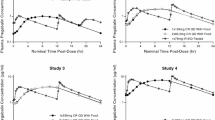Summary
Plasma theophylline concentrations have been measured in 14 normal subjects following the oral administration of a microcrystalline theophylline preparation (MT) 187.5 mg every 6 h and a sustained-release theophylline preparation (SRT) 375 mg every 12 h for 5 days. During the 5 days, blood samples were drawn before and 2 h after each morning dose with MT, and before and 4.5 h after each morning dose of SRT. On days 1 and 5, more frequent samples were taken during the dose interval. With both preparations, steady-state plasma concentrations were achieved by the third day. The trough levels were significantly higher with SRT than with MT on days 3 and 4, and the levels at 4.5 h after SRT were significantly higher than those measured 2 h after MT on days 3, 4 and 5. Over the terminal 3 days of the study, mean theophylline concentrations with SRT ranged between 11.2 and 15.5 µg/ml at measured trough and peak times, whereas the mean trough levels with MT were always below 10 µg/ml. With adjustment for the dosage differences, the mean ratio of the areas under the plasma concentration/time curves for the final dosage interval for the two formulations (AUCSRT/AUCMT) was 1.29±0.56, suggesting that the SRT preparation was well absorbed. The “mean” steady-state plasma theophylline concentrations (AUC/dose interval) on day 5 were 11.5±4.7 µg/ml with MT and 13.7±5.7 µg/ml with SRT. Nine subjects experienced a total of 35 side-effects whilst taking MT, compared with 10 subjects complaining of 23 side-effects on SRT. These results indicate that, in normal subjects, SRT 375 mg every 12 h exhibited satisfactory sustained-release properties and achieved adequate mean plasma theophylline concentrations during chronic administration. It produced higher plasma levels and a lower incidence of side-effects than the same daily dose of MT.
Similar content being viewed by others
References
Jenne JW, Wyze E, Rood FS, MacDonald FM (1972) Pharmacokinetics of theophylline. Application to adjustment of the clinical dose of aminophylline. Clin Pharmacol Ther 13: 349–360
Jonkman JHG, Berg WC, Schoenmaker R, De Zeeuw RA, Orie NGM (1979) The absolute bioavailability of microcrystalline theophylline. Curr Med Res Opin 6. Suppl 6: 71–76
Kelly JG, Leahey WJ (1976) Measurement of theophylline in plasma by high performance liquid chromatography. Br J Clin Pharmacol 3: 947
Mitenko PA, Ogilvie RI (1973) Rational intravenous doses of theophylline. N Engl J Med 289: 600–603
Piafsky KM, Ogilvie RI (1975) Dosage of theophylline in bronchial asthma. N Engl J Med 292: 1218–1222
Weinberger M, Riegelman S (1974) Rational use of theophylline for bronchodilatation. N Engl J Med 291: 151–153
Author information
Authors and Affiliations
Rights and permissions
About this article
Cite this article
Russell, C.J., Elwood, R.K., Kinney, C. et al. Plasma theophylline concentrations following the oral administration of microcrystalline theophylline and a new sustained-release theophylline preparation to normal subjects. Eur J Clin Pharmacol 18, 351–354 (1980). https://doi.org/10.1007/BF00561394
Received:
Revised:
Accepted:
Issue Date:
DOI: https://doi.org/10.1007/BF00561394




